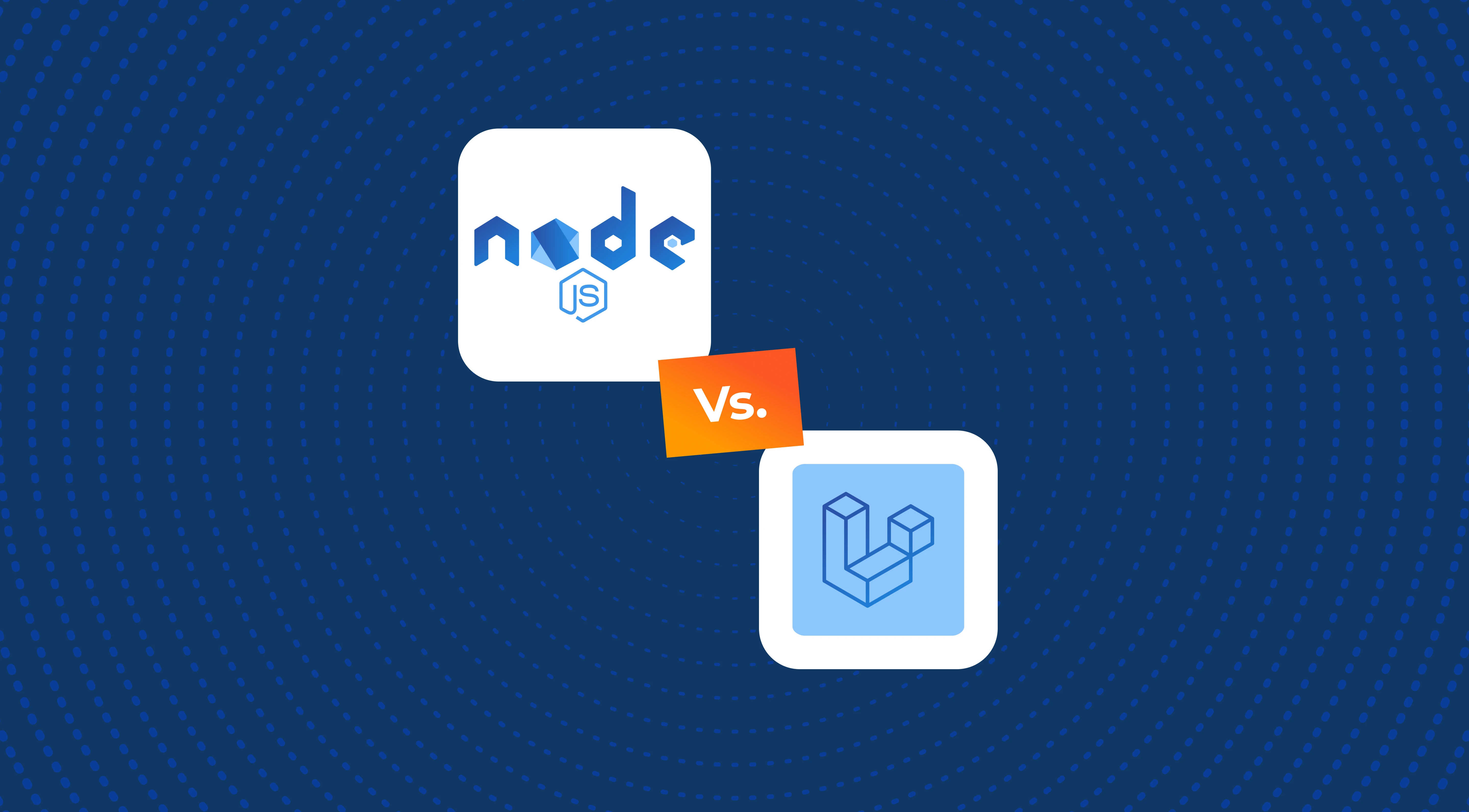SHARE
Node.js vs. Laravel: Which is Better in 2025?

Contents
Contents
The battle between Node.js vs. Laravel continues to deepen among developers in 2024. The growing web application frameworks market fuels the dilemma.
Node and Laravel have their own advantages and disadvantages in 2024. Therefore, the choice depends on the project requirements that suit each need.
Factors to consider when choosing between the two frameworks include the scalability and performance requirements of the application and the nature of the project.
Wondering what to go for between Node and Laravel? This article contains detailed information about the two. Keep reading to find out!

What is Node.js?
Node.js is a cross-platform, open-source framework that functions as a backend JavaScript runtime environment. It is built on the V8 engine allowing developers to use JavaScript on the server side.
It gives a model that is non-blocking I/O and event-driven. That makes it efficient and light enough to build scalable, high-performance web applications.
Node.js contains a large, active community with many packages and modules. These can be accessed through the Node Package Manager (npm).
What is Node.js used for?
The cross-platform runtime environment has various uses for web development and individual activities. Some of the most common uses include the following.
- Creating web APIs used to expose functionality and data to other applications.
- Building web applications like server-side web using frameworks like Nest.js and Express.js.
- Real-time applications like multiplayer games, chat apps, and collaborative tools. It is well suited to handle real-time data events.
- Serverless applications through platforms like Azure Functions and AWS Lamda. These two platforms give room for writing serverless functions.
- Command-line tools are used to manage workflows, automate tasks and perform system-level operations.
Node.js is a wide and powerful platform used for various purposes and by various applications. The active community ensures that it remains a popular choice in years to come.
Popular Node.js Web Frameworks
There are a number of popular Node.js Web Frameworks used in web application development, some of these include the following.
- Koa.js is one of the new Node.js frameworks built by Express.js creators. It leverages modern JavaScript features.
- Express.js, which is a popular web framework. It is flexible and light enough to build APIs and web applications for its wide variety of tools.
- Nest.js, which is a Typescript-based web framework. It is built on Express.js to give modular architecture. That allows developers to have an easy time organizing their code.
- Hapi.dev which is a flexible and yet powerful Node.js web framework. It gives an architecture that is plugin-based, and useful for building APIs and web applications.
- Meteor.js which is used by full-stack developers to build APIs and web applications.
Generally, all these frameworks contain a wide variety of tools and features for building APIs and web applications. The frameworks are classified according to the size and complexity of the project.

What is Laravel?
Laravel is a free PHP web application framework. It gives users tools and features that help in easy web development.
Laravel follows the MVC pattern. It also has features like middleware, templating, routing, authentication, and database interactions.
The framework has a user-friendly command line interface and many users who add to its development. It is powerful and yet easy to use, providing efficient services to developers.
What is Laravel used for?
Software developers use Laravel to build content management systems, e-commerce platforms, APIs, and web applications.
It uses PHP and provides features and tools that make it easy for developers to build maintainable and scalable applications.
Application Programming Interfaces (APIs) allow users to expose functionality and data to other applications.
It has built-in support for RESTful API development, which eases up the building of APIs used to communicate over HTTP.
Laravel is used to create Content Management Systems among other complex applications. It has a modular architecture that helps in extending and customizing.
It also has built-in support for Eloquent ORM that helps in simplifying database interactions.
E-commerce platforms and online marketplaces support payment gateways, order management, and product catalogs through Laravel.
Advantages of Node.js over Laravel
Both Node.js and Laravel have their own advantages. However, they depend on the project specifics opted for by users.
Some advantages of node.js over Laravel include the following.
- Node.js is known for its high performance when it comes to applications that need real-time communication of huge data processing.
- It is highly scalable and therefore, it handles large amounts of concurrent connections with little overhead.
- Node.js is considered a server-side JavaScript platform. That means developers can use the same language for back-end and front-end development.
- Node.js has a large community that contributes to its development. It also creates third-party packages that provide a wide range of functions.
Generally, Node.js is the best choice for building highly scalable and performant applications. The applications require real-time communications or data processing in large amounts.
Advantages of Laravel over Node.js
Both Laravel and Node.js are popular for their functions in building web applications. However, each has its disadvantages and advantages depending on the user specifics.
Some advantages of Laravel over Node.js include the following.
- Laravel has rapid application development. It involves a wide range of built-in tools and features that make it easy for users to build applications.
- Laravel has comprehensive documentation that makes it easier for users to read and understand as compared to Node.js.
- It also has a strong Object Relational Mapping system known as Eloquent. Eloquent gives room for simple and easy communication with databases.
- Laravel has serious security measures that help users to keep their applications secure. Some of the features include encryption, CSRF, and hashed passwords.
Generally, Laravel could be a good choice for software developers who prefer vast features and rapid application development.
Node.js vs. Laravel Comparison
Node.js and Laravel have their strengths and weaknesses when building web applications.
Node.js is fast and a better choice for applications that require real-time communications or large data processing.
Laravel framework is easier to use and has a better preference for all-sized applications. All complexities can also be solved by Laravel.
Node.js uses JavaScript for both back-end and front-end development. Laravel uses PHP programming language.
Node.js is not advisable for CPU-intensive applications. This is because it first sets all the CPU available to process heavy requests coming to the event loop.
It then answers the incoming requests in the queue. The pile-up leads to slow processing and delays in the event loop.
On the other hand, Laravel is a server-side platform that supports CPU-intensive operations. There may be limited delays in the event loop compared to Node.js.
Both have many users depending on the specifics they offer and those required by the software developer.
Programming Language – PHP vs JavaScript
PHP and JavaScript are programming languages used by web developers. Sever-side web developers use PHP, while front-end web developers use JavaScript code and other JavaScript modules in web development.
PHP has various built-in features that are helpful in databases. It’s known for its scalability and speed. JavaScript is flexible and versatile. It allows developers to build dynamic user interfaces.
JavaScript engine is popular amongst front-end web developers. PHP is common to back-end web developers in large-scale web applications.
Learning Curve
The PHP learning curve varies from that of JavaScript depending on various factors. These include the experience of the programmer and project specifics.
PHP is known to have a low learning curve for developers who have used Java or C++. JavaScript on the other hand has a steeper learning curve for new programmers.
JavaScript has a more complex syntax compared to PHP and requires users to study new concepts like Document Object Model and asynchronous programming.
Stability
PHP and JavaScript are stable programming languages. They both have a large number of users and well-established ecosystems of libraries and tools.
PHP was introduced many years ago as well as JavaScript. They have both been supported by web servers and developers who have contributed to their stability.
PHP focuses on backward compatibility. That means codes written in the older versions work in newer versions.
Generally, JavaScript and PHP are stable enough, and developers are confident when using them. They are also well-established programming languages.
Community Support
The open-source PHP framework contains a large community that helps in development and improvement.
It also has a variety of web services, such as blogs, online forums, and documentation, that help users to learn and troubleshoot concerns.
Popular PHP frameworks like Symfony, Laravel, and CodeIgniter have their own communities that also help to contribute to development and support.
JavaScript also has a number of users who contribute to its development. Its most popular frameworks include Angular, React, and Vue.js. they also have their communities add value to them.
Generally, both PHP and JavaScript have many users. They give frameworks, tools, and support to their users in managing development projects.
Popularity
In terms of popularity, both PHP and JavaScript are well-known and used for web development projects. However, their popularity varies depending on the applications and uses.
PHP is popular with server-side web developers. Majority of the content managing systems like Drupal, WordPress, and Joomla use PHP during development.
Popular e-commerce platforms like WooCommerce and Magento use PHP. Enterprise web applications especially those built on the LAMP stack use PHP extensively.
The JavaScript framework’s popularity has seen a surge in recent years. Front-end developers use frameworks like Angular, React, and Vue.js to build web applications.
Node.js in JavaScript, recently introduced, can be used for server-side development, increasing in popularity.
Generally, both JavaScript and PHP are popular. Their popularity is based on the needs of the developers or the type of projects.
Node.js versus Laravel: Which is Better?
Node.js is popular for its ability to build real-time, fast, and scalable web applications. It also has a number of users, libraries, and frameworks that help speed up the building process of an application.
On the other hand, the Laravel framework is popular in enterprise-level web development. It is best suited for applications that require complex business logic and database.
It has many users as well as a variety of tools and built-in features. These help to speed up the building of applications.
The choice made solely depends on the developers and the type of project. Node.js is useful for real-time and high-level interactivity projects.
Laravel is useful for projects that require security, scalability, and high complexity. All these requirements should be considered before choosing between the two.
Summary: Node.js and Laravel Web Applications
Both Laravel and Node.js have unique features and large popularity in the specifics they perform.
However, the decision made depends on the user requirements they both offer.
Laravel and Node.js will remain viable development options for as long as possible. That is because of their stability, popularity, and community support.
Node.js is popular for its ability to build real-time, fast, and scalable web applications, while Laravel is popular for its security, scalability, and high level of complexity.
Node.js uses JavaScript programming language. It is also favorable to front-end developers. Laravel uses PHP programming language, which mostly favors back-end software developers.
Frequently Asked Questions
What is the node package manager (NPM)?
The Node Package Manager (NPM) is a JavaScript package manager tool suited to Node.js. It started as an enabler of downloading and managing dependencies of Node.js packages.
It manages packages like frameworks, libraries, and tools for Node.js applications. As of September 2022, there were 2.1 million packages in the npm registry.
NPM is a crucial tool for Node.js users. It contributes to the growth of the Node.js ecosystem by making sharing and reusing codes easy.
What alternatives are there to Node.js and Laravel in Web Development?
There are various alternatives to Node.js and Laravel. They depend on the specifics of the project. Some of them include the following.
- Flask is considered a lightweight web application framework. It is mainly used for the Python programming language.
- ASP.NET is a web application framework by Microsoft. It is used to build applications with .NET.
- Django is another competitive web framework that helps developers to build scalable network applications.
- Ruby on Rails is a framework mostly used by Ruby programming language users.
How do you learn Node.js development?
Node.js developers use it to create web applications and websites. Other creations include online games, stores, and social media sites.
JavaScript computer language is necessary when learning Node.js. The JS runtime environment is a great resource for built-in libraries available to learners.
The easy scripting language makes it easy for learners to understand various JavaScript modules.
To start learning, users have to install the js file on a computer and try experimenting with building simple web pages or games.
Many materials can be used online to teach learners how to use Node.js. The Node.js community is also useful to learners to gain skills and networks.
What is a backend web framework?
A backend framework is a toolkit or library that aids software developers with websites and applications. The framework gives modules and a set of tools that guide developers in writing codes efficiently.
Backend web frameworks are crucial in custom web development as they typically contain features like authentication, security, routing, and database integration. They also offer support for WebSockets, APIs, and other web technologies.
Developers are able to have an easy time in developing and focusing on scalable, and secure applications when using the backend web framework.
Professional Node.js Development Services
Flatirons offers top-rated Node.js development services.
Get the CEO's Take
Handpicked tech insights and trends from our CEO.
Professional Node.js Development Services
Flatirons offers top-rated Node.js development services.
Get the CEO's Take
Handpicked tech insights and trends from our CEO.

Perl vs Python: Choosing the Right Scripting Language
Flatirons
Apr 20, 2025
IoT Database: Manage Connected Device Data Efficiently
Flatirons
Apr 14, 2025
Proof of Concept Template: A Step-by-Step Guide
Flatirons
Mar 26, 2025
Objective C vs Swift: Which is Better for iOS App Development?
Flatirons
Mar 25, 2025
Scala vs Kotlin: Comparing the Functional Programming Giants
Flatirons
Mar 22, 2025
IoT Smart City Solutions: Transforming Urban Living
Flatirons
Mar 17, 2025